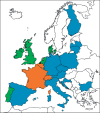Microbiological Screening of Platelet Concentrates in Europe
- PMID: 31191193
- PMCID: PMC6514488
- DOI: 10.1159/000499349
Microbiological Screening of Platelet Concentrates in Europe
Abstract
The risk of transfusion-associated sepsis due to transmission of bacteria is a persistent problem in the transfusion field. Despite numerous interventions to reduce the risk, cases of bacterial sepsis following transfusion are repeatedly being reported. Especially platelet concentrates are highly susceptible to bacterial contaminations due to the growth-promoting storage conditions. In Europe, blood establishments and national authorities have implemented individual precaution measures to mitigate the risk of bacterial transmission. To obtain an overview of the different approaches, we compiled information from national authorities, blood establishments, and the current literature. Several aspects such as the shelf life of platelets, time of sampling and the applied control measures are compared between the member states. The analysis of the data revealed a broad heterogeneity of procedures on a national level ranging from platelet release without any safety testing up to mandatory screening of all platelet concentrates prior to transfusion. Despite the substantial progress made in recent years, several bacterial reports on transfusion-associated sepsis indicate that further efforts are needed to increase the safety of blood transfusions in the long term.
Keywords: Bacterial contamination; Blood safety; Infection; Pathogen inactivation; Platelet concentrates; Sepsis; Transfusion-associated infections.
Figures


Similar articles
-
Current debate on pathogen inactivation of platelet concentrates--to use or not to use?Transfus Apher Sci. 2010 Dec;43(3):411-414. doi: 10.1016/j.transci.2010.10.012. Epub 2010 Nov 13. Transfus Apher Sci. 2010. PMID: 21075686
-
[Single-donor (apheresis) platelets and pooled whole-blood-derived platelets--significance and assessment of both blood products].Clin Lab. 2014;60(4):S1-39. doi: 10.7754/clin.lab.2014.140210. Clin Lab. 2014. PMID: 24779310 Review. German.
-
Improving the bacteriological safety of platelet transfusions.Transfus Med Rev. 2004 Jan;18(1):11-24. doi: 10.1016/j.tmrv.2003.10.002. Transfus Med Rev. 2004. PMID: 14689374 Review.
-
Bacterial contamination of blood components: Norwegian strategies in identifying donors with higher risk of inducing septic transfusion reactions in recipients.Transfus Apher Sci. 2014 Oct;51(2):97-102. doi: 10.1016/j.transci.2014.08.007. Epub 2014 Sep 1. Transfus Apher Sci. 2014. PMID: 25242310 Review.
-
Bacterial contamination of platelets for transfusion: strategies for prevention.Crit Care. 2018 Oct 27;22(1):271. doi: 10.1186/s13054-018-2212-9. Crit Care. 2018. PMID: 30367640 Free PMC article. Review.
Cited by
-
PRP and PRF-Subgroups and Divisions When Used in Dentistry.J Pers Med. 2021 Sep 23;11(10):944. doi: 10.3390/jpm11100944. J Pers Med. 2021. PMID: 34683085 Free PMC article. Review.
-
Expanded validation of the effect and quality of a pathogen inactivation system based on riboflavin photochemistry on platelet bacterial contamination.Ann Transl Med. 2021 Dec;9(23):1736. doi: 10.21037/atm-21-5834. Ann Transl Med. 2021. PMID: 35071430 Free PMC article.
-
Growth and Distribution of Bacteria in Contaminated Whole Blood and Derived Blood Components.Transfus Med Hemother. 2024 Feb 21;51(2):76-83. doi: 10.1159/000536242. eCollection 2024 Apr. Transfus Med Hemother. 2024. PMID: 38584696 Free PMC article.
-
Implementation of a blood proficiency testing scheme for bacterial screening of platelet components.Vox Sang. 2025 Apr;120(4):401-410. doi: 10.1111/vox.13803. Epub 2025 Feb 17. Vox Sang. 2025. PMID: 39961285 Free PMC article.
-
Evaluation of bacterial safety approaches of platelet blood concentrates: bacterial screening and pathogen reduction.Front Med (Lausanne). 2024 Apr 5;11:1325602. doi: 10.3389/fmed.2024.1325602. eCollection 2024. Front Med (Lausanne). 2024. PMID: 38651065 Free PMC article. Review.
References
-
- Duke WW. The relation of blood platelets to hemorrhagic disease. By W.W. Duke. JAMA. 1983 Sep;250((9)):1201–9. - PubMed
-
- WHO WHO Model List of Essential Medicines: 20th List. 2017
-
- British Committee for Standards in Haematology, Blood Transfusion Task Force Guidelines for the use of platelet transfusions. Br J Haematol. 2003 Jul;122((1)):10–23. - PubMed
-
- European Commission Summary of the 2016 annual reporting of serious adverse reactions and events for blood and blood components. 2016
-
- EUROPEAN PARLIAMENT AND THE COUNCIL OF THE EUROPEAN UNION: Directive 2002/98/EC setting standards of quality and safety for the collection, testing, processing, storage and distribution of human blood and blood components.
Publication types
LinkOut - more resources
Full Text Sources

